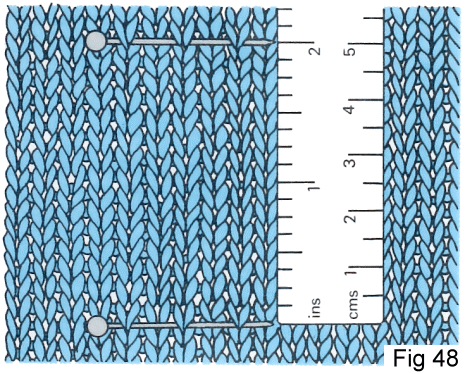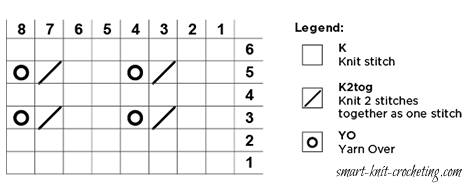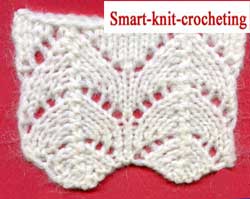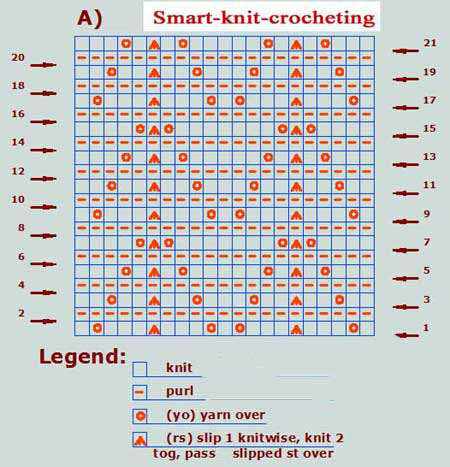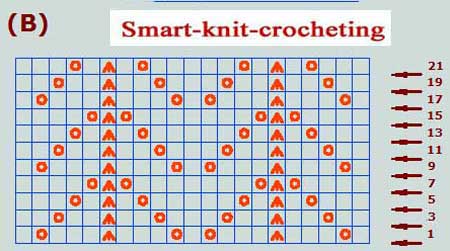
Knitting yarn may be made up from a combination of different fibres.
Yarn can of animal origin (wool, angora, mohair, silk, alpaca), vegetable origin (cotton, linen) or man-made (nylon, acrylic, arayon).
Yarn is the term used for strands of soun fibre which are twisted together into a continuous thread of the required thickness. Each single strand of yarn is known as a ply, A number of plys are twisted together to form the yarn. The texture and characteristics of the yarn may be varied by the combination of fibress and by the way in which the yarn is spun. Wool and other natural fibres are often combined with man-made fibres to make a yarn that is more economical and hard-wearing. Wool can also be treated to make it machine washable. The twist of the yarn can be varied too. A tightly twisted yarn is firm and smooth and knits up into a head-wearing fabric. Loosely twisted yarn has a softer finish when knitted

Click here to see more.
comes from a domesticated sheep. Wool accepts dye well, is flame-retardant by nature, remains warm even when wet, sheds water better than other yarns. Natural wool should be hand-washed. 'Superwash' wool has been treated to allow machine washing. Wool will usually resume its proper shape when washed correctly; if it is mistreated and washed in too-hot water, it will shrink or felt.
Mohair comes from an Angora goat. Mohair is durable, sheds dirt, dyes well and does not felt easily. Despite its hardiness, it is usually spun into knitting yarn used for fluffy garments and scarves. This knitting yarn is abraded, roughing its fibers to create that 'fuzzy' look
Angora comes from rabbits. Fabric made from this yarn is inelastic, very fluffy, soft and warm.
Silk is the yarn produced by silk moths. Silk knitting yarn is made from damaged silk cocoons and broken fibers. 'Raw' silk still has the original moth secretions in it. 'Tussah,' silk obtained from wild moths is brown. The food fed to domesticated moths determines their silk's natural color; this can white, green or yellow. Silk retains heat, absorbs moisture, pills less than wool, is very strong and very stable when knit, neither shrinking or stretching.
Cashmere comes from the undercoat of a Cashmere goat. It is so expensive because only a few ounces are obtained from each goat per year. It is such a delicate yarn, more fragile than wool and more susceptible to abrasion, that it is usually blended with wool to make it more durable
Camel comes from the two-humped or Bactrian camel. Camel hair cannot be bleached, so it is either used undyed or dyed a darker color. It is lightweight and fragile
Vicuna comes from the vicuna, a South American relative of the camel. They are rounded up once a year and shorn like llamas or sheep; their hair is finer than any other animal yarn.
Alpaca is a smaller relative of the llama but its hair is more commercially valuable. Knitting yarn does not felt or pill easily. It comes in fifteen natural colors (as do the alpacas) and is denser than wool . The undercoat of a llama is very similar to alpaca hair
Qiviut (kiv-ee-uht) the yarn itself is very hard to find. It comes from a musk ox and resembles pale gray cashmere but does not shrink.
Vegetable knitting yarns:
Cotton comes from surrounding the seeds in a cotton pod. Cotton is heavy, dense and inelastic; although it will regain its shape after washing, its ability to do so decreases over time. It is comfortable to wear in a cool climate but not a hot one (the opposite of wool) and is slow to dry once wetted. It makes a weaker knitting yarn than silk or linen but is stronger than wool.
Linen comes from the flax plant. It is durable and stronger than any other yarn. It absorbs moisture better than cotton and dries more quickly, making it more comfortable to wear than cotton in hot temperatures. It is easier to wash than wool and does not stretch or shrink.
Ramie is made from nettles It is often used as a substitute for linen since it is less expensive but shares linen's good qualities.
Rayon is a yarn produced from natural ingredients by artificial means.Rayon is a weak fiber but it is absorbent, dries quickly, and stretches (although it does recover some when dried in a automatic dryer.)
Synthetic knitting yarns:
Nylon is lightweight, strong, elastic, resists abrasion, does not stretch or shrink (except at high temperatures,) and is easy to wash. It is usually combined with wool to impart its strength and elasticity to the wool.
Polyester is the most common type of synthetic yarn. Yarn made from it retains its shape. It adds strength and resilience to natural yarns. Polyester is very easy to wash and is more comfortable to wear than many other synthetics.
Acrylic is the most common synthetic in knitting yarns. They are resilient, moderately strong, somewhat inelastic, feel good to the hand and are light in weight. Acrylics are easily made to imitate natural yarns so they are sold as alternatives to wool. However, acrylics cannot wick away moisture from the body so their warmth diminishes when wet. The yarn burns readily unless treated and will shrink in moist heat. Acrylics are often used to achieve novel textures and characteristics that are not available with natural yarns.
Metallic yarn (described above) is best used as a 'knit-along' with another, stronger yarn.
Fuzzy yarns obscure a stitch pattern but are warmer and cozier, although they wear less well and often shed like a St. Bernard in a Georgia summer.
Novelty yarns are ones with an unusual texture, color or appearance that comes through differences in its ply sizes, the combinations of its fibers or some variation in its spinning.
hand knitting yarn Slub knitting yarn has a textured, lumpy surface. It has a smooth ply and one that was spun unevenly, which creates 'slubs' or lumps in the ply.
Crepe knitting yarn has tiny bumps.
Boucle knitting yarn has its smooth ply so tightly twisted that it curls around the slub ply
Roving, mentioned above, is loosely spun wool. It is a weak knitting yarn and can pull apart while being knit. Once made up, the fabric itself holds the fibers together; although warm, the fabric will pill, abrade and does not wear well.
Eyelash or fur knitting yarn has long filaments grouped along its length. When the yarn is knitted, these filaments stick out from the fabric and give it a furry look.
Chenille is cut from a specially woven fabric. It twists while being knit because it has no oppositely-twisted plies to counteract the twist imparted by the knitting. It sheds from its cut edges.
hand knitting yarn Ribbon yarn is just that: thin ribbon used for knitting. Although most knitters let the yarn twist as it may, fine ribbon-knitting keeps each stitch as flat and smooth as possible.
See:
Berroco Yarn,
Lion Brand Yarn

